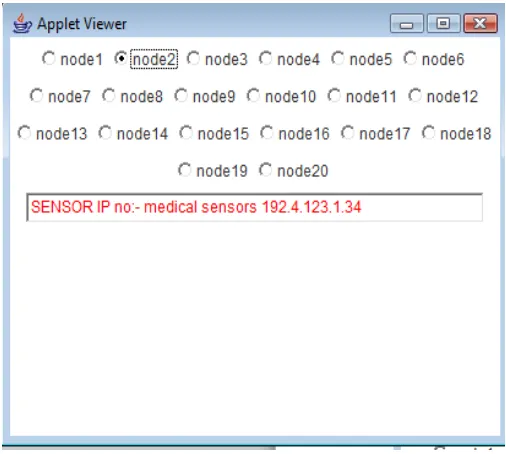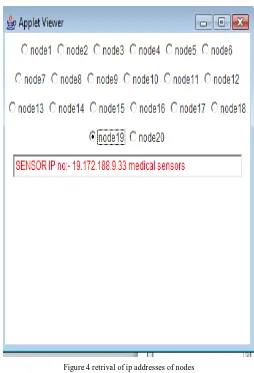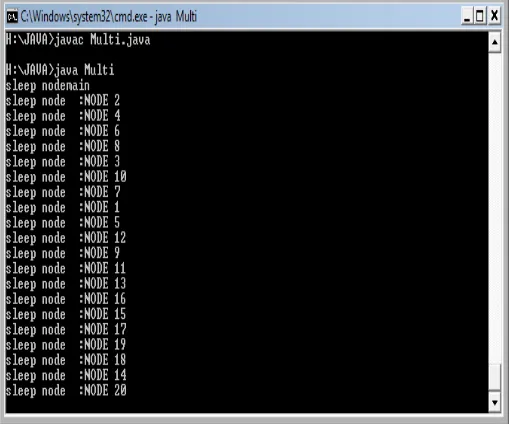Volume 3, No. 5, Sept-Oct 2012
International Journal of Advanced Research in Computer Science
RESEARCH PAPER
Available Online at www.ijarcs.info
ISSN No. 0976-5697
On Improving the Energy Efficiency of a Sensor Node in Multi-Patient Monitoring
System
Merris Mary Chacko*
PG Scholar VIT University, Vellore
Tamil Nadu, India merrismary@gmail.com
Meena Jose
PG Scholar VIT University, Vellore
Tamilnadu, India josemeena@gmail.com
Sneha baby thomas
PG Scholar VIT University ,Vellore
Tamilnadu,India snehababy123@gmail.com
R.K.Nadesh
Assistant Professor(Senior) VIT University, Vellore
Tamilnadu,India rknadesh@vit.ac.in
Abstract: In this contemporary world the need of monitoring multiple patients at a time in hospitals has risen much higher than before. This makes a tremendous growth in the health care systems. The multi-patient monitoring system uses wireless sensor networks for monitoring the health of the patient and capturing their heath parameters. This paper proposes several ways for increasing the reliability and reducing the power consumption of real time multi-patient monitoring system. These sensor nodes collect data at regular intervals, then convert the data as electrical signals and finally send those signals to the base node. Twenty remote nodes and one central node with PC-based graphical user interface are considered. Sleep strategies and other power saving mechanisms are adopted to achieve the goal of low power consumption. The sleep – wake schedule is introduced to reduce the time and power when the sensors are idle. In terms of efficiency and reliability the multi-patient monitoring system has proved much better than single patient monitoring systems which are currently used in hospitals. This leads to better treatment in hospitals by giving appropriate treatments at the right time to the patients.
Keywords: Wireless sensor networks (WSNs), Sleep-wake monitoring, Energy Efficiency, Wireless nodes.
I. INTRODUCTION
The primary aim of hospitals across the globe focuses on public health. The need for betterment in treatment and to increase the quality of monitoring has regarded as the substantial aspect of health care. Various health care monitoring systems are targeted to meet the health needs of the humanity. Wireless technologies are conventionally considered as an essential determinant in promoting the regular health and prosperity of mankind around the world. A wireless sensor network includes spatially dispersed sensor nodes spread out over a specific area for monitoring physical phenomenal variations and continuously transfer data to a main location through network. Typically sensor nodes are tiny devices consisting of basic components like a sensing subsystem for data attainment from the targeted environment, processing subsystem for data processing and storage and a wireless communication subsystem for data transfer. In addition, a power source to enable various programmed task. This power supply source consists of a battery with finite budget. Moreover it’s a heavy task and inconvenient to recharge battery of nodes which are employed in a hostile environment. The lifetime of the sensor networks prolongs for months or even years to satisfy the application requirements.
In all cases, energy is a very significant resource and must be used very economically. Therefore energy conservation is
the consequential key issue in the design of systems based on the wireless sensor networks(WSN).In this paper a sensor network is considered which consists of one sink node or base station and twenty sensor nodes deployed in a hospital ward to monitor multi-patients. Data are transferred from sensor nodes to the sink through wireless networks. With the invention of Bluetooth and Wi-Fi patients need not required to be confined on their beds rather they can walk freely around their room but should keep a specific distance from the bedside sensing system as the range of a typical Bluetooth system is about ten meters. As a result network nodes that use protocols like Bluetooth require a major volume and higher power consumption. This suggests about the huge cost per node and a fairly high burden on its power consumption. Such protocols are used for moderate to high bandwidth applications where comparatively large packets of data need to be transmitted as well as received. In case of patient monitoring system, the data packet size is much smaller so it might seem impractical to use such protocols. So it is evident to use low power consumption mechanism for such applications.
wakeup state and together they are known as frame. Duty cycle is the ratio of wakeup state to the total frame length time and it should be kept small in order to avoid wastage of energy. To save energy, each node wakes up after periodic intervals independent of other nodes in the network. Various kind of sleep-wake scheduling protocols are discussed in [2]. In these protocols, neighboring nodes share synchronized information periodically with the sensor nodes. Whenever the health status of a patient seems normal the current node can be kept in sleep mode. Concurrently this can be done with all other nodes. Each node is kept in sleep and wake mode from the central node. Programming methodologies are adopted for this task. If any abnormal condition occurs warning message is send to the sink. Corresponding doctor is informed when a warning message is seen on the monitor of the base station. Simultaneously two nodes can be kept in sleep mode even though wake up time varies.
II. RELATEDWORKS
Author in [1] presents packet forwarding scheme called anycast where each nodes will get a packet from the neighboring nodes as an alert message to wake up candidate node. The optimization of anycast forwarding scheme is done for reducing the expected overheads from the sensor nodes to the base node. The usage of scheduling protocol and the anycast forwarding protocol extends the networks overall life period. These are mainly used in practical situations like lake or a mountain which are under the control of wireless sensor networks. Two optimization problems are solved here. Firstly, the wake up rates is identified and an efficient algorithm is developed for the minimization of the expected delay from distributed nodes to the sink. Secondly, life-time maximization problem is controlled by sleep-wake scheduling and anycast policy.
Author in [2] proposed a Dynamic Sleep Scheduling (DSS) for reducing overheads in wireless sensor networks.DSS has the capability to identify nodes with different scheduling criteria in accordance with their traffic load at two phases, according to their topologies and by handling burst traffic in the candidate node. The usage of heuristics DSS decreases the end-to-end delay and minimize energy per packet by reducing the congestion at node with high traffic loads.
Author in [3] introduces a mobile phone technology into health care system. A prototype of wireless health proctoring system efficient in promoting Short Message Service (SMS) regarding the medical health parameters of the patient is put forward. When a variation in patients health is found or any abnormal situation is reached the developed health monitoring system immediately sends SMS to the doctors mobile through mobile network via SMS gateway or GSM device on the other hand the hospital database gets updated automatically. Entire project is divided into three stages, data achievement, data processing and directive stages. This systems helps to prevent patients death by inform doctors at the right time.
Author in [4] develops a low power, wireless wearable patient monitoring system named VMote which records temperature of skin, saturation of oxygen (spO2), heart pumping rate (HR), blood volumetric pressure (BVP) and
galvanic skin resistance (GSR). Base node collects data wirelessly from the sensors.Vmote will ease data acquisition from many networks.
Author in [5] did study on heath monitoring of huge infrastructures. A retrieval system convenient to transmit signal of huge structures wirelessly is put forward. Due to sudden response frequencies of large buildings special concern is given to the tiny response time characteristics of wireless sensor. The results show that the developed system and proctoring methods are suitable for tangible health proctoring and outrage detection of large infrastructures.
Author in [6] stipulates about a promising revolution in health care by allowing low-priced, non-invasive, unending, ambulatory heath monitoring by the usage of internet. This system utilizes off-the-shelf 802.15.4 complaint network nodes and heart activity sensors. This paper gives solution for time synchronization, power reduction and on- chip processing.
Author in [7] presents a practically possible health monitoring device. Together with continuous monitoring and analysis of physiological signs it incorporates Body Sensor Networks (BSN). It results in low power, flexible and compact design of BSN which provides adaptable environment for wireless sensing research and development.
Author in [8] proposed a health care for the elderly. This is a combination of three systems with different functionalities. One system detects the variation in heart rate. The other is developed for detecting the rate of respiration level. The last one is the system used to detect amount of cough using contacted sensors. The procedures of method starts with the fast Fourier transform which leads to feature extraction and which ends up in the detection of diseases.
Author in [9] presented a system to design a latest structure for cloud computing known User Interface as a Service (UlaaS).It is compactable with web platforms which explicitly aims at supporting health monitoring based on cloud services for health care. The device integrates sophisticated and intelligent backend environment.
Author in [10] proposes a both hardware and software architecture for wireless health monitoring system systems. This system includes multiple sensors that proctor the motion of body and activity of heart, a network controller and an individual server.. The result delivers on the spot feedback from user and other officials.
III. MATERIALSANDMETHODS
a. Sleep-wake methodology is used to reduce the power consumption.
b. Java programming is used to implement sleep-wake methodology.
c. If there are 20 nodes for 20 patients and suppose any five of them are not in use they can be kept in sleep mode using centralized control.
d. Power consumption is highly reduced by making nodes to sleep.
ensuring its normal make the node to sleep for 5min or so.
f. The very moment the patient is shifted from room to operation theatre the corresponding node can be put to sleep.
[image:3.612.342.551.153.369.2]There are two states in sleep -wake schedule a. Wake state(when the node is active) b. Sleep state (when the node is in rest mode)
Figure 1 different type of sensor states
Without depending on topology or connectivity criteria sleep-wake scheme can be defined for a sensor node. Sleep-wake protocols are of three types: on-demand scheduled rendezvous and asynchronous schemes. On-demand protocol takes the instinctual method to reduce power consumption. Here the node should wakeup only when some other node wants to communicate with it. Such types of schemes use many radios with different power efficiency tradeoffs to the sleeping node as an alert that another node is waiting to communicate with it. On–demand sleep-wake up scheme is focused at reducing power consumption in the monitoring part. It also ensures a limited intermission for transmitting data. This scheme is more appropriate for sensor network systems where duty cycle is low like health care monitoring systems. In such cases, nodes are in monitoring state. When any event is detected, nodes changes to transmit mode to relocate data. In scheduled congregate approach each node should wake up at the same time as its neighbor. Nodes follow a wakeup schedule and remain active for a short interval to communicate with the neighbor. Then again go to sleep until next congregation time. With asynchronous protocols, there is no specific time for the nodes to wake up. So, whenever the nodes wake up they can still be able to transfer information with the neighbors. This aim is fulfilled by properties implied in sleep-wake schemes. Therefore, every node periodically turns to its wakeup state to active state for specific duration. When the sink has to communicate with the nodes, a stream of signals is send to the wakeup channel. The moment these nodes receives signals it sends back a wakeup call and moves to a wake up state.
Software has been developed and is accountable for establishing communication between the base station and twenty nodes. Software is developed using Java. A platform called DrJava is adopted for writing java programs. It is a lightweight development environment which provides an intuitive interface to evaluate java code. The standardized libraries in java supply a universal way to highlight features like threading and networking.
[image:3.612.46.281.160.275.2]Hardware used is medical sensors such as ActiS sensor node. It has got productive set of functions to support operating system .This wireless nodes needs wireless sensor platform like Telos from Moteiv. A central graphical system with high configuration is used which acts as the central node. Wireless personal area network (WPAN) is adopted to send and receive data from each node to the central system. The wireless area network comprises of three layers as shown in figure 2
Figure 2 layers in network
IV. RESULTS AND DISCUSSION
Each individual node is given an ip address and is invoked according to its address. The central node acts as the parent and remaining as child nodes. A tree structure is visualized where the central node acts as the master and the remaining nodes as slave. A master-slave environment is created where the master has got the entire control over each node. These nodes are the medical sensors which capture and sense the variation in the patient’s body. It collects data and transfers to the central node which is the base station.
[image:3.612.323.576.496.723.2]Twenty nodes with unique address is created. Each time a node get selected for any fuction it is recognised by its ip address and is displayed in the central system.Any functions can be done over the nodes from the central node. It also indicates the actions of the node.The ip address is used to identify which node is in transmission state and in reception state so that the central system can be ready to accept as well as receive data.By adopting this method in hospitals each patient can be monitored carefully for every single minute there by enchancing treatment methodology.
Figure 4 retrival of ip addresses of nodes
By selecting appropriate nodes we can make it into sleep as well as wake mode.when the health status of any patient shows normal from the central node we can make it into sleep for five minutes or so and can again awake it from the same central node.These are medical sensors which indicates the variation in the patients body like high blood pressure,low sugar,cardiac attack and so. If there occurs any high variation in health status nodes sends signal to the base node and from there doctor in charge of that particular patient can be informed and adequent steps and meassures can be taken in fragment of time. Every node can be controlled and can be kept in sleep mode as well as wake mode which will reduce the power consumption
Figure 5- Tree structure of nodes
The central node acts as the parent and remaining as child.The parent can control the activities of the child.Here a master -slave scenario is being created.This reduces the energy flow from sleep to active state.Tree structure is more appropriate for representing nodes and it will direct and minimizes the threshold. By adopting this structure overheads can be reduced. The overall controlling power is given to parent node only and this node receives all kind of data from various nodes and it stores and manipulates the data appropriately.
[image:4.612.33.287.171.544.2]Figure 6 indication of a normal health status
[image:5.612.41.292.56.348.2]When health status is normal it will be indicated at the central node since it has followed a tree hierrarchy. Each time the status is normal the mode of thecorresponding node can be changed to sleep state for few minutes and again changes into wake up state. This process keeps on going as far as the the monitoring is required. For an example the sugar level in a patients body need not be checked every minute so the coressponding node can attain a sleep state untill the sugar level is recorded for next time.
Figure 7 shows theSleep-wake scheduling
Figure 8 Sleep mode insisted
When a node remains in its sleep state no data transfer occurs. The node will be in an inactive state until its hit by a wake up call. When any patients health status remains normal the transmission is stopped and in such situation a profitable amount of energy is conserved . Each time the node goes to its sleep state energy consumption is reduced and there by provide high efficiency in wireless sensor networks.
[image:5.612.36.292.480.730.2]
Figure 9 shows 0% transmission of data
Figure 10 shows 90% transmission of data
Figure 11 shows 100% transmission of data
[image:5.612.330.571.508.673.2]Figure 12 indication of high signal variation
[image:6.612.40.290.58.389.2]When any tremendeous change in health occurs the signal from the corresponding node is indicated high in the central node.Random values are generated to show high and low signal variation. If the transmission shows high signal a warning message is displayed on the base station screen. More than one node can send high signal at the same time to the sink.
[image:6.612.36.291.498.710.2]Figure 13 indicates the sleep node randomly
Figure 14 Warning messages to doctors when signal is high
When warning messgae is shown at the base station the corresponding doctor is informed through mobile,pager or through internet .This leads to easy and better mode of dealing with the patients in hospitals. Hence right treatment is given at right time.
V. CONCLUSION
The present system provides twenty patients with real-time, reduced power, reduced cost, long-distance, and dual-mode monitoring. The centralized control will help the nodes to sleep and wake according to the need. The reduction in power consumption is attained by this sleep-wake scheme and there by enables the monitoring of multiple patients in an efficient way. Moreover monitoring a patient has become an easy task. Concept of threading and networking is merged to implement the sleep-wake mechanism. The sleep-wake scheduling plays a vital role in reducing power consumption. Efficiency and reliability is attained for the wireless personal network and outnumbered the qualities of single patient monitoring system.
VI. REFERENCES
[1] Joohwan, K., L. Xiaojun, et al."Optimal Anycast Technique for Delay-Sensitive Energy-Constrained Asynchronous Sensor Networks." Networking, IEEE/ACM Transactions on
[2] Nazir, B. and H. Hasbullah. Dynamic sleep scheduling for minimizing delay in wireless sensor network. Electronics, Communications and Photonics Conference (SIECPC), 2011 Saudi International. Saudi Arabia: 1-5,2011.
[3] B. Priya, S. Rajendran, et al. "Remote Wireless Health Monitoring Systems." Innovative Technologies in Intelligent Systems and Industrial Applications: 1-5,2009.
[4] Hughes, E., M. Masilela, et al. VMote: A Wearable Wireless Health Monitoring System. 9th International Conference on e-Health Networking, Application and Services. Taiwan:
330-331,2007.
[5] Wang, D. H. and W. H. Liao. Instirumentation of a Wireless Trainsmission System Health Monitoring of Large Infrastructures. IEEE Instrumentation and Measurement Technology Conference. Budapest, Hungary: 1-6,2001.
[6] Milenkovic, A., C. Otto, et al. "Wireless Sensor Networks for Personal Health Monitoring:Issues and an Implementation."
2: 1-29,2008.
[7] Lo, B., S. Thiemjarus, et al. "Body Sensor Network-A wireless Sensor Platform for Pervasive Healthcare Monitoring." 25,2008.
[8] Hata, Y., S. Kobashi, et al. Human Health Monitoring System of Systems by Non-Contacted Senors. System of Systems Engineering, 2009. SoSE 2009. IEEE International Conference 1-5,2009
[9] Dimitrova, M., S. Lozanova, et al. "Cloud Computing Framework for New Medical Interface Technologies." Cloud Computing Framework: 1-6,2009.



